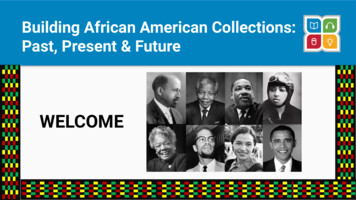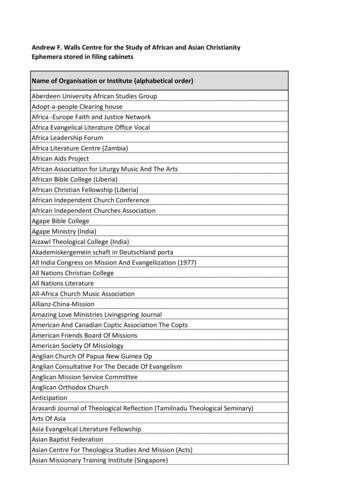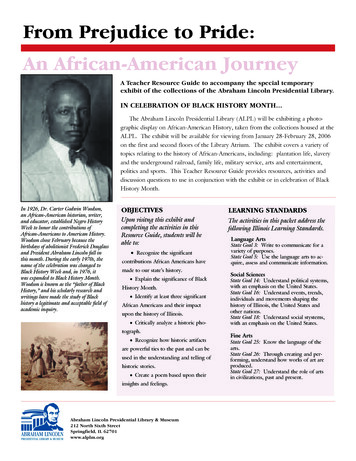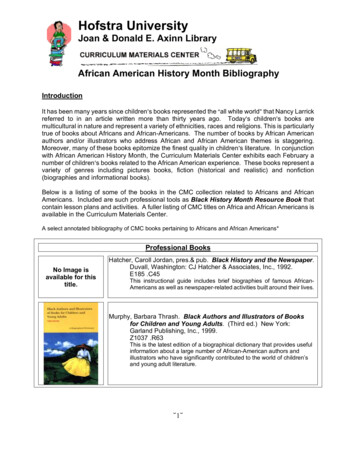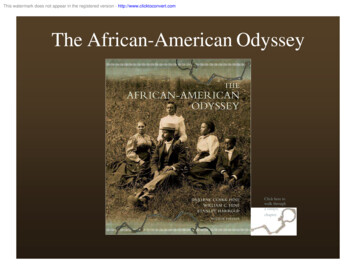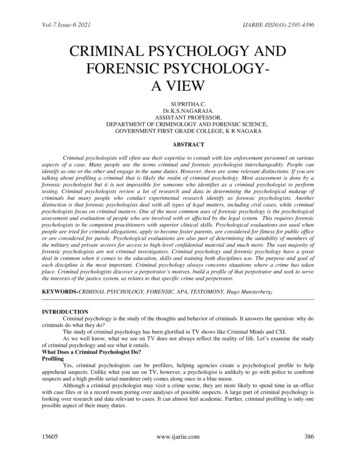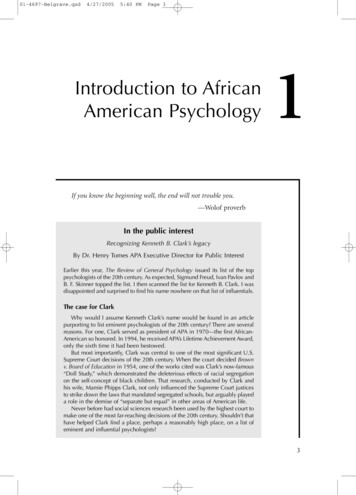
Transcription
01-4697-Belgrave.qxd4/27/20055:40 PMPage 3Introduction to AfricanAmerican Psychology1If you know the beginning well, the end will not trouble you.—Wolof proverbIn the public interestRecognizing Kenneth B. Clark’s legacyBy Dr. Henry Tomes APA Executive Director for Public InterestEarlier this year, The Review of General Psychology issued its list of the toppsychologists of the 20th century. As expected, Sigmund Freud, Ivan Pavlov andB. F. Skinner topped the list. I then scanned the list for Kenneth B. Clark. I wasdisappointed and surprised to find his name nowhere on that list of influentials.The case for ClarkWhy would I assume Kenneth Clark’s name would be found in an articlepurporting to list eminent psychologists of the 20th century? There are severalreasons. For one, Clark served as president of APA in 1970—the first AfricanAmerican so honored. In 1994, he received APA’s Lifetime Achievement Award,only the sixth time it had been bestowed.But most importantly, Clark was central to one of the most significant U.S.Supreme Court decisions of the 20th century. When the court decided Brownv. Board of Education in 1954, one of the works cited was Clark’s now-famous“Doll Study,” which demonstrated the deleterious effects of racial segregationon the self-concept of black children. That research, conducted by Clark andhis wife, Mamie Phipps Clark, not only influenced the Supreme Court justicesto strike down the laws that mandated segregated schools, but arguably playeda role in the demise of “separate but equal” in other areas of American life.Never before had social sciences research been used by the highest court tomake one of the most far-reaching decisions of the 20th century. Shouldn’t thathave helped Clark find a place, perhaps a reasonably high place, on a list ofeminent and influential psychologists?3
01-4697-Belgrave.qxd44/27/20055:40 PMPage 4INTRODUCTION AND HISTORICAL FOUNDATIONHow did this happen?The method used by the Review of General Psychology survey to generatethe list of notables provides some clues as to how Clark was omitted. It reliedheavily on the number of times an author was cited in journals and textbooksand on a survey of a sample of American Psychological Society members. Otherfactors were also taken into consideration, such as National Academy ofSciences membership, serving as APA president and being a recipient of theAPA Distinguished Scientific Contribution Award. These criteria, particularlythe number of journal and textbook citations, possibly worked against Clark.Certainly he was not short on honors and awards.Still puzzled by his omission, I sought information about Clark from theLibrary of Congress, which, as it turned out, had quite a bit—168,500 itemsderived from publications, speeches, work papers and more that spanned196 linear feet and occupied 500 boxes. Even a cursory review of these materials reveals a lot about how Clark spent his time. In addition to psychology, heworked with the National Association for the Advancement of Colored People,the Urban League and other groups involved with the civil rights movementof the 1950s and 1960s. He and his wife were involved in many organizationsthat benefited the New York community in which they lived.It is likely that he was one of the most socially active psychologists of theera when minorities, primarily African-Americans, struggled for equal rightsand justice in America.So, after my investigations, the question remains: How could such a distinguished psychologist be omitted from such a list?There are clearly honors for psychologists whose works are cited byothers—that is how the discipline advances. But there are some acts and ideasthat cannot be ascertained by numbers. Eminence may be one of them.Kenneth Clark and his works, in my opinion, deserve better.Introduction, Definition, and Conceptual FrameworksThe preceding article provides a brief narrative of one “eminent” AfricanAmerican psychologist and makes a convincing argument for whyDr. Kenneth Clark should be included as one of the top psychologistsof the 20th century. Notably, Dr. Clark’s work was a major contributingfactor to one of the most significant U.S. Supreme Court decisions of the20th century, and according to Tomb, he was one of the most sociallyactive psychologists of the era. As we will see in this chapter, severalAfrican American psychologists along with Dr. Clark have made significant contributions in the field of psychology and in the wider society.African American psychology encompasses many topics. In thischapter, we provide definitions and discuss conceptual frameworks for
01-4697-Belgrave.qxd4/27/20055:40 PMPage 5Introduction to African American Psychologystudying and understanding African American psychology. Then, weexamine historical influences on the study of African American psychology. The contributions of African American psychologists in defining andconceptualizing African American psychology are discussed in a sectionon self-determination. Following that section, we review the current statusof African American psychology. Methodological issues are addressed, andthe chapter ends with a summary.WHAT IS AFRICAN AMERICAN PSYCHOLOGY?The fields of African American, Black, and African psychology havebeen defined by several scholars. Baldwin (1986)—a.k.a. Kambon—definesBlack psychology this way:African (Black) Psychology is defined as a system of knowledge (philosophy,definitions, concepts, models, procedures, and practice) concerning thenature of the social universe from the perspectives of African cosmology.Black psychology is nothing more or less than the uncovering, articulation,operationalization, and application of the principles of the African realitystructure relative to psychological phenomena. (p. 242)African American psychology has been studied primarily from two perspectives. The first perspective is that psychological concepts and theoriesare universal and thus, African Americans can be studied using universal laws and principles. The second perspective, taken from Africentricscholars, is that African American psychology is the psychology of peopleof African descent and these beliefs and behaviors are central to the studyof African Americans. In this book, we use a convergent approach thatcaptures both perspectives.Baldwin’s definition encompasses an Africentric perspective. Africentricpsychology is discussed in more detail in Chapter 2. Africentric psychology considers core values, beliefs, and behaviors found among peopleof African descent and central to understanding African Americans. Likewise, Azibo (1996) considers African American psychology to be Africanor Black psychology. He writes, “All human life processes including thespiritual, mental, biological, genetic, and behavioral constitutes Africanpsychology” (pp. 6–7). In these definitions, Baldwin and Azibo do not makea distinction between African psychology and African American psychology, arguing that all people with origins in Africa are African.One way of understanding the two perspectives in the psychology ofAfrican Americans is to consider differences between two schoolsof thought regarding Black/African psychology (Azibo, 1996). One schoolof thought is pro-Black and the other is pro-Africentric. In contrasting thetwo, Azibo notes that the pro-Black school of thought has focused on the5
01-4697-Belgrave.qxd64/27/20055:40 PMPage 6INTRODUCTION AND HISTORICAL FOUNDATIONAfrican in the U.S. experience and has not used the African structure toprovide the patterns for interpreting the experience of African Americans.Although this school of thought has been useful in changing myths aboutBlacks based on a deficit model, it does not capture the core of the Africanexperiences. To capture the core African experience, Azibo advocates thatan Africentric proactive school of thought be taken. This school takes theposition that African philosophy is critical to understanding the psychology of Black/African people. To understand African American behavior,one must understand the behavior of Africans.Baldwin similarly makes a distinction between Black psychologyand African psychology (Baldwin, 1991). According to Baldwin, Blackpsychology was formed as a reactionary to Western psychology. The Blackpsychological approach concerns itself with the psychological consequenceof being Black in America. However, Baldwin argues that because Africanpeople preexisted European people as a distinct cultural group, it followsthat a distinct African psychology existed, irrespective of when and how itwas articulated by social scientists. Baldwin makes the point that indeedBlack psychology is African psychology.Aldelbert Jenkins (1995, 2004) takes a different approach in his studyof the psychology of African Americans. Jenkins uses a humanistic perspective taken from Western psychology. A core assumption of the humanisticapproach is that African Americans have always been and are currentlyactive, planful, and proactive in shaping their destinies. Jenkins abandonsthe mechanistic conceptualization that posits that one’s behavior is causedby external environmental forces. Instead he maintains that even underthe most oppressive situations, individuals make choices and strive to exertsome control over their outcomes. Jenkins notes that subtle efforts thathave historically and or are currently being made by African Americans areoften directed at resisting oppression. These efforts may not be conceivedas logical from the perspective of Whites, but they have been useful inhelping African Americans define themselves and have made possible analternative conception of self. Jenkins provides the example of how moneyspent by a poor African American man on luxury items, such as an expensive car, may be seen as irrational behavior. However, according to Jenkinspurchasing an expensive car could be an act of resistance for this individual.A luxury item may help him to define and express a sense of dignity thatotherwise would not be obtained from an oppressive environment.Convergent PerspectivesThere are convergent viewpoints in conceptualizing the psychology ofAfrican Americans. Both perspectives acknowledge that African Americanpsychology is a science and, consistent with a Western conceptualization ofpsychology, it is organized and structured. This means that there is a systematicapproach to understanding the psychology of African Americans, although
01-4697-Belgrave.qxd4/27/20055:40 PMPage 7Introduction to African American Psychology7there may be disagreement on the methods used for conducting scientificwork. Both perspectives consider the scope and content of African or AfricanAmerican psychology to be fairly broad and diverse. African/AfricanAmerican psychology includes the study of behaviors as well as thoughts,feelings, beliefs, attitudes, and ways of interacting and being. All perspectives underscore the importance of self-definition and self-determination.For example, from the perspective of Africentric scholars, self-knowledgeis a requisite for achieving well-being. Jenkins’s humanistic theory alsoacknowledges the striving for self-determination and mastery.African and Western PsychologyAfrican American psychology can be distinguished from Westernpsychology, not only by the population studied (i.e., African Americans),but also by the nature of the discipline. Azibo (1996) distinguishes Africanpsychology from Western psychology by its nature and essence. According to Azibo, the essence of African psychology was seen in the practiceof the people from Kemit (ancient Egypt, the place of original civilization).The Kemit approach to understanding humans was through self-realization,whereas Western psychology’s approach was through domination (Kambon,1998).One feature of Western psychology is the importance that is placed onobservable behavior. Although Freud’s influence made the unconscious apart of the scope of Western psychology, psychology has primarily focusedon that which can be observed. The focus on observable behavior is attributed to the great weight that Western psychology has placed on predictionand control of the behavior of people. African psychology considers selfknowledge and intuition to be as important as that which is observable(Grills, 2004; Myers, 1988).In summary, there is no one definition of African American psychology. The definition depends on the perspective that is taken regarding theinfluence of African and American/Western cultures on the psychologyof African Americans. We acknowledge both African and American influences on behavior.Historical Perspective on thePsychological Study of African AmericansORIGINS OF AFRICAN PSYCHOLOGYAfrican American psychology began in ancient Kemit (Egypt), a civilization that began in 3200 B.C. According to Azibo (1996), African
01-4697-Belgrave.qxd84/27/20055:40 PMPage 8INTRODUCTION AND HISTORICAL FOUNDATIONpsychology can be traced to the period in time in which Africans producedan “organized system of knowledge (philosophy, definitions, concepts,models, procedures, and practice concerning the nature of the social universe” (p. 4). From this perspective, African American psychology preexisted Western psychology. African psychology is discussed in more detailin the next chapter.EUROPEAN SCIENTISTS’ CONTRIBUTION TO RACISMIn 1976, Robert Guthrie published the book, Even the Rat Was White.The second edition was published in 1998. This book reviews the contributions of the European scientific community in influencing Americanpsychology and beliefs about Blacks and how Blacks have been studiedover the past two centuries. The book illustrates how scientific racismcontributed to the perception of the inferiority of Blacks and justification for racism and oppression. Contributions from Guthrie’s book arehighlighted next.Comparative Studies in Physical AnthropologyStudies done by physical anthropologists in the late 18th and 19th centuries compared differences in the physical attributes of Blacks and Whites(Guthrie, 1976/1998). These included skin color, hair texture, skull shapeand size, facial structure, and posture. Observed differences were alwaysfound in favor of the superiority of Whites and the inferiority of Blacks. Instudies that looked at skull size as an indicator of intelligence, it was concluded that the Black man’s skull and brain were smaller and therefore lesscomplex than the White brain.In 1898, the Cambridge Anthropological Society began a cooperativeventure between psychology and anthropology. When scientists were sentto New Guinea to study the mental attributes of its residents, they concluded that the natives of the South Pacific were inferior to Westerners onall traits, including intelligence. This study was the beginning of studies ofracial differences.Darwin’s Survival of the FittestIn 1859, Darwin published his theory on the survival of the fittest.The key assumption of this theory was that only the strongest and mostintelligent could survive. According to Guthrie (1976/1998), this doctrinegreatly influenced American psychology by emphasizing individual differences, an assumption that currently underlies much of the work in psychology. The vast majority of research on African Americans within the
01-4697-Belgrave.qxd4/27/20055:40 PMPage 9Introduction to African American Psychologyfield of psychology during the first half of the 20th century looked atindividual differences in the psychological attributes of African Americansand Whites. The findings generally showed African Americans to be inferioron individual difference variables.Galton’s EugenicsGalton’s work in the 19th century also contributed to promoting a beliefin the racial inferiority of Blacks. Galton’s theory was that intelligence andother personality attributes were inherited. If intelligence were inherited,then one would not expect those of lower intelligence to improve in ability(Guthrie, 1976/1998). Galton’s theory of eugenics was promoted to improvethe race through selective mating and sterilization. The improvement of thehuman race could be done by genetic control of those who were of inferiorintelligence and those who were social deviants. The application of eugenics resulted in Blacks and other ethnic minorities being disproportionatelyincluded among those who were inferior and unfit.AMERICAN SCIENTISTS’CONTRIBUTION TO SCIENTIFIC RACISMLike their European counterparts, American scientists also conductedresearch to support the intellectual inferiority of African Americans(Guthrie, 1976/1998). The implication of this research on social policy hasadversely affected African Americans.Jensen’s (1969) work on intelligence encouraged the belief that somepeople were genetically inferior to others. According to Jensen, intelligencewas essentially determined at birth, and genetics or inheritance accountedfor about 80% of intelligence. Note the similarity between this theory andthat of eugenics.In regard to public policy, a theory that intelligence is predeterminedadversely affects people who may need environmental and social supportsto improve their conditions. For example, compensatory programs such asHead Start were designed to provide economically disadvantaged childrenan academic boost prior to beginning school. However, if the reasoningis that intelligence is fixed at birth, there is little that can be done to changeone’s ability, and compensatory programs are not likely to do much good.Research on the intellectual inferiority of African Americans is seen inmore contemporary times in the work of Hernstein and Murray’s (1994)book, The Bell Curve. These authors provided data that suggest that intelligence differs among racial groups and that African Americans are atthe lowest end of the bell curve. A major point of the book is that mostsocial problems, especially those found among economically and socially9
01-4697-Belgrave.qxd104/27/20055:40 PMPage 10INTRODUCTION AND HISTORICAL FOUNDATIONmarginalized people, cannot be solved because they are linked to intelligence,which is mostly inherited. Therefore, environmental supports put in placeto solve these problems will not be useful if the cause of the social problemis due to intelligence that is inherited.A broad implication of The Bell Curve is that the poor, the uneducated,and the unemployed—of whom African Americans constitute a sizeablepercentage—will live a life of unproductivity. Social programs cannot helpthese individuals, due to their lower intelligence (Haynes, 1994). Anotherimplication of The Bell Curve is that people who are socially and intellectually inferior cause many of the social problems in this country.The Bell Curve has been subject to intense scrutiny and criticismbecause of its erroneous assumptions and methodological flaws (Fairchild,1994; Haynes, 1994). The inference of causality based on correlational datais a major methodological flaw as is the importance given to what an intelligence tests means. That is, to assume that lower intelligence scores causesocial problems is erroneous when cross-sectional correlational data areused to make these assumptions. Also, to assume that an intelligence testscore is the best indicator of intelligence, adaptability, and general lifesuccess is flawed.Intelligence TestingIntelligence testing, according to Guthrie (1976/1998), was an importantfactor in perpetuating scientific racism during the first part of the 20thcentury. Binet and Spearman were early contributors to scientific racismin that their work on intelligence testing was used to show intellectualdifferences between Blacks and Whites.In 1904 Alfred Binet, a French physician, developed the Simon-BinetScale, the forerunner of the Stanford-Binet test of intelligence that is stillin use today. Charles Spearman developed the two-factor theory of intelligence that says that mental tests measure two factors: a general factor anda specific factor. The assumption is that the general factor measures general intellectual capability. The problem with this conception of a generalfactor of intelligence is that it emphasizes the general intellectual capacitywhile deemphasizing other mental attributes that may be more contextualor culturally specific (Williams, Williams, & Mitchell, 2004).The earliest test of racial differences in intelligence was done using theBinet scales in 1912. In this study, Alice Strong measured the intelligenceof 225 White children and 1,125 Black children. Black children were alsocategorized according to skin color (dark, medium, and light). Strong (asquoted in Guthrie, 1976/1998) noted that the “colored children excelled inrote memory . . . however, they are inferior in aesthetics judgment, observation, reasoning, motor control, logical memory, use of words, resistanceto suggestion, and in orientation or adjustment to the institutions and
01-4697-Belgrave.qxd4/27/20055:40 PMPage 11Introduction to African American Psychologycomplexities of civilized society” (p. 64). In other words, the Black childrenwere inferior to Whites on conceptual and intellectual attributes.In 1916, Ferguson published a study titled, The Psychology of the Negro:An Experimental Study. This study was considered a classic. It reported thatthe Negro had deficits in abstract thinking, but was very capable in sensoryand motor abilities. Given capacity in these types of skills, Negroes should beuseful for doing manual work. Overall, much of the early work of Americanscientists perpetuated the myth of Black inferiority.STUDY OF AFRICAN AMERICANSIN AMERICAN PSYCHOLOGYIn American psychology, studies of Negroes, Coloreds, Blacks, AfroAmericans, and African Americans have been conducted throughoutthe last century in the United States. Often, theories and conceptual frameworks that may be useful for Western psychology have been erroneouslyapplied to the psychology of African Americans. For example, consider theconcept self-esteem, a frequently studied topic in Western and Americanpsychology. In understanding what self-esteem is from an African as wellas a Western perspective, one must understand the difference betweenWestern and African conceptions of the self. Using a Western definition,self-esteem can be defined as a feeling of liking and regard for one’s self.From an Africentric perspective, the personal self is indistinguishablefrom the self that is derived from membership in the African community(Nobles, 1991). Therefore, one’s affiliation to one’s group defines one’sview of self. The African proverb, “I am because we are and we are becauseI am,” characterizes this notion of the self. Thus, the self-esteem of peopleof African descent may be different from that of Whites, and it also mayfunction differently for African Americans than for Whites (see Chapter 9for a more detailed discussion).Another approach taken by American psychology has been to useinformation gathered from White populations as the norm and then tocompare African Americans with Whites. This approach is seen with theuse of measures that have been developed to assess individual differencetraits. For example, continuing with the example of self-esteem, a measureof self-esteem that does not include the collective nature of self-esteemmay not be relevant for African Americans. Given the problem of nonnormative data, we have seen, over the past two decades, more effortdirected at the inclusion of African Americans and other ethnic and cultural groups within normative samples when measures are developed.A related problem is when methods that are based on Western psychology are used to study African Americans. As will be discussed in Chapter 2,the method for acquiring knowledge may differ for different cultural11
01-4697-Belgrave.qxd124/27/20055:40 PMPage 12INTRODUCTION AND HISTORICAL FOUNDATIONgroups. According to Africentric scholars, self-knowledge is the mostimportant type of knowledge and is the basis for all knowledge. Selfknowledge then is more important than knowledge that is acquired fromthe external environment. In this regard, understanding how a person whoparticipates in a research project perceives him- or herself may be just asimportant as seeing how he or she responds to external stimuli.Within American psychology, the preferred methodology for conducting research has been the experiment. Experiments are believed to be superior in producing valid and factually correct information. Experiments alsoprovide a context in which predictions—and subsequently control—can bemore exact. Yet, experimentation may not be the best way to obtain information about African Americans. Other, more naturalistic methods such asinterviewing and systematic observations may be more useful singularly orin conjunction with experimental approaches.A large percentage of studies done in American psychology havefocused on differences among African Americans and Whites. During thefirst part of the 20th century, most of the research conducted on AfricanAmericans involved comparative studies that contrasted African Americansand Whites on individual difference traits (Guthrie, 1976/1998). This focuson differences led to African Americans being viewed as having deficits onmany psychological characteristics. Studies that examine within-groupdifferences among African Americans are just as important to aid inunderstanding why some African Americans do well and others do not.In the next section, we provide an overview of comparative studies onAfrican Americans.COMPARATIVE STUDIESThe vast majority of the studies conducted by psychologists on AfricanAmericans during the first half of the 20th century were studies that compared Colored, Negroes, and Blacks with Whites. For the most part, thesestudies examined differences between African Americans and Whiteson intelligence, mental ability, and personality. Studies were conductedwith children, adolescents, and adults. Studies on intellectual differencesemployed standard individual intelligence tests such as the Stanford-Binet,as well as group tests to assess mental functioning. One such test usedwas the Army Classification Battery (ACB). The ACB was developed by thearmy to assess soldiers’ aptitude on different assignments. The ACB testwas used in several studies that examined differences in mental ability andintelligence between African Americans and Whites. One study that examined differences between Negroes and Whites on the ACB of intelligencefound that Negroes scored lower than Whites (Roen, 1961).Other studies conducted during the first half of the 20th century investigated differences between African Americans and Whites on personality
01-4697-Belgrave.qxd4/27/20055:40 PMPage 13Introduction to African American Psychologyattributes, traits, and temperaments. Findings from representative studiesare reviewed next. The method used to carry out these studies was influenced by the social and political climate of the time, with most findingsreflecting negatively on African Americans. These studies, which almostalways found inferior traits among African Americans, contributed to theclimate of racism and discrimination against African Americans.A study published in the 1920s is illustrative of the studies of this era.Peterson (1923) tested White and Colored children using several groupintelligence tests and individual learning tests. He found significant racedifferences, with White children scoring higher on both group and individual tests. He noted in his findings that the White 8-year-old children scoredhigher than the Negro 10-year-old children. Peterson pointed out that thesedifferences were especially salient because of the fact that 60% of the White8-year-old children came from poor sections of the city, whereas 97% of the10-year-old Negro children came from one of the best Negroes schoolsin the city. He reported that about 83% of the Whites were smarter thanthe Negroes, and that only 15% to 18% of the Negroes were as smart as theWhites. According to Peterson, differences between the two groups weremost striking on tasks that required abstract and logical thinking. In making recommendations stemming from his findings, he suggested that therebe less abstract and conventional types of education for Negro children.Peterson did not mention that even though the Negro children may haveattended one of the best Negro schools in town, these schools had substantiallyfewer resources than the poor White schools.Findings of inferior functioning among African Americans were alsoseen in early studies on personality traits. Roen (1961) found that Negroesin his study lacked self-confidence more than did Whites. Furthermore,low self-confidence among Negroes was associated with lower intelligencetest scores. Roen speculated that the lack of pride in historical achievement, coupled with a negative socioenvironmental context, had led tointernalized intellectually defeating personality traits that contributed tolower intelligence scores.Many studies found that African Americans had elevated scores forproblem behaviors. For example, Hokanson and Calden (1960) foundeven when Negroes and Whites both came from predominately northernworking-class settings, Negroes had personality deficits higher in severalareas of the Minnesota Multiple Personality Inventory (MMPI). The authorssuggested that special norms be developed for Negro and White subjects.Regarding general adaptation to society, studies found that White andNegro adolescents of similar mental ability differed in personal and socialadjustment (Pierce-Jones, John, Jackson, & King, 1964).In a review of psychological studies published between 1943 and 1958,Dreger and Miller (1960) found that Whites were superior to Negroeson several attributes including psychophysical, psychomotor, intelligence,and temperament traits (i.e., neuroticism). They noted that differences13
01-4697-Belgrave.qxd144/27/20055:40 PMPage 14INTRODUCTION AND HISTORICAL FOUNDATIONbetween Negroes and Whites were smaller amo
wise, Azibo (1996) considers African American psychology to be African or Black psychology. He writes, "All human life processes including the spiritual, mental, biological, genetic, and behavioral constitutes African psychology"(pp.6-7).In these definitions,Baldwin and Azibo do not make a distinction between African psychology and .
